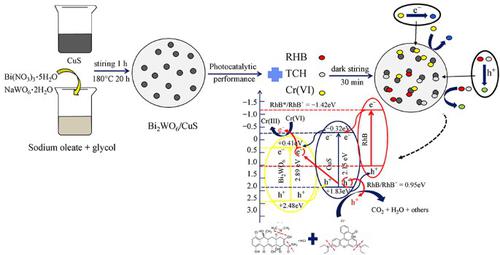Frontiers of Environmental Science & Engineering ( IF 6.1 ) Pub Date : 2020-10-08 , DOI: 10.1007/s11783-020-1344-8 Wei Mao , Lixun Zhang , Tianye Wang , Yichen Bai , Yuntao Guan

|
A visible-light-driven Bi2WO6/CuS p-n heterojunction was fabricated using an easy solvothermal method. The Bi2WO6/CuS exhibited high photocatalytic activity in a mixed system containing rhodamine B (RhB), tetracycline hydrochloride (TCH), and Cr (VI) under natural conditions. Approximately 98.8% of the RhB (10 mg/L), 87.6% of the TCH (10 mg/L) and 95.1% of the Cr(VI) (15 mg/L) were simultaneously removed from a mixed solution within 105 min. The removal efficiencies of TCH and Cr(VI) increased by 12.9% and 20.4%, respectively, in the mixed solution, compared with the single solutions. This is mainly ascribed to the simultaneous consumption electrons and holes, which increases the amount of excited electrons/holes and enhances the separation efficiency of photogenerated electrons and holes. Bi2WO6/CuS can be applied over a wide pH range (2–6) with strong photocatalytic activity for RhB, TCH and Cr(VI). Coexisiting dissolved organic matter in the solution significantly promoted the removal of TCH (from 74.7% to 87.2%) and Cr(VI) (from 75.7% to 99.9%) because it accelerated the separation of electrons and holes by consuming holes as an electron acceptor. Removal mechanisms of RhB, TCH, and Cr(VI) were proposed, Bi2WO6/CuS was formed into a p-n heterojunction to efficiently separate and transfer photoelectrons and holes so as to drive photocatalytic reactions. Specifically, when reducing pollutants (e.g., TCH) and oxidizing pollutants (e.g., Cr(VI)) coexist in wastewater, the p-n heterojunction in Bi2WO6/CuS acts as a “bridge” to shorten the electron transport and thus simultaneously increase the removal efficiencies of both types of pollutants.
中文翻译:

高效Bi 2 WO 6 / CuS复合材料的制备用于可见光催化去除废水中的有机污染物和Cr(VI)
使用简单的溶剂热法制备了可见光驱动的Bi 2 WO 6 / CuS pn异质结。Bi 2 WO 6/ CuS在自然条件下,在包含若丹明B(RhB),四环素盐酸盐(TCH)和Cr(VI)的混合体系中表现出较高的光催化活性。在105分钟内从混合溶液中同时去除了大约98.8%的RhB(10 mg / L),87.6%的TCH(10 mg / L)和95.1%的Cr(VI)(15 mg / L)。与单一溶液相比,混合溶液中TCH和Cr(VI)的去除效率分别提高了12.9%和20.4%。这主要归因于同时消耗电子和空穴,这增加了激发的电子/空穴的数量并增强了光生电子和空穴的分离效率。Bi 2 WO 6/ CuS可以在很宽的pH范围(2–6)上使用,对RhB,TCH和Cr(VI)具有很强的光催化活性。溶液中共存的溶解有机物显着促进了TCH(从74.7%到87.2%)和Cr(VI)(从75.7%到99.9%)的去除,因为它通过消耗空穴作为电子受体来加速电子和空穴的分离。 。提出了去除RhB,TCH和Cr(VI)的机理,将Bi 2 WO 6 / CuS形成为pn异质结,以有效地分离和转移光电子和空穴,从而驱动光催化反应。具体而言,当减少污染物(例如TCH)和氧化性污染物(例如Cr(VI))共存于废水中时,Bi 2 WO 6中的pn异质结/ CuS充当缩短电子传输的“桥梁”,从而同时提高两种污染物的去除效率。











































 京公网安备 11010802027423号
京公网安备 11010802027423号